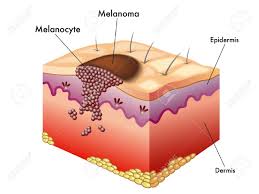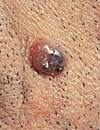
Diagnosed with Cancer? Your two greatest challenges are understanding cancer and understanding possible side effects from chemo and radiation. Knowledge is Power!
Learn about conventional, complementary, and integrative therapies.
Dealing with treatment side effects? Learn about evidence-based therapies to alleviate your symptoms.
Click the orange button to the right to learn more.
- You are here:
- Home »
- Blog »
- side effects ID and prevention »
- Skin Cancer- Over-Diagnosis, Over-treatment
Skin Cancer- Over-Diagnosis, Over-treatment

“But some in the specialty are beginning to question the necessity of aggressive screening and treatment, especially in frail, elderly patients, given that the majority of skin cancer…
Skin cancer is the most common diagnosis of all cancers annually in the United States. Specifically non-melanoma skin cancer.
Over-Diagnosis and Over-Treatment in cancer is nothing new. Breast and Prostate cancer patients are working to understand their treatment options after an early stage diagnosis. Now however, over-diagnosis and over-treatment of skin cancer is questioned in the New York Times article linked and excerpted below.
While reading the article below all I could think about were my parents’ history of skin cancers. Dad passed away in late ’15 from heart disease and mom is currently living in an assisted-living facility.
Both mom and dad loved the outdoors. Both loved the sun. Both my folks have had multiple non-melanoma skin cancer diagnoses over the past dozen or so years (’05-’15- age 75-85).
My question is how do the findings in the article below relate to my parents’ skin cancer experiences? Were mom and dad over-diagnosed and over-treated?
I underwent aggressive chemo and radiation for a cancer diagnosis in 1994. One of my many therapy-induced side effects is an increased risk of non-melanoma skin cancer.
Consider the same evidence-based but non-conventional therapies that have keep me free from skin cancer since my chemotherapy in 1995.
How can patients sporting numerous spots on their skin know it a mole/freckle/etc. is life threatening!?
According to the NYTs article below the number of skin biopsies performed on Medicare patients in 2015, 5.9 million, was a 55% increase compared to biopsies performed in 2005. 15% of those biopsies were performed by physician assistants, not medical doctors.
I’ll never know if any of my folks’ skin cancer diagnoses/biopses from ’05-’15 were what the NYT considers over-diagnosis/over-treatment or not. Unless you are in the room with a person getting a diagnosis of skin cancer you can’t really know what the doctor/PA/nurse tells them.
Like all instances of over-diagnosis and over-treatment the key is for the patient to understand what he/she has been diagnosed with, the possible therapies and the side effects of those possible therapies.
To learn more about other evidence-based therapies that can help prevent the development of non-melanoma skin cancer or relapse, please watch the short video below:
While asking all the questions above might seem like it’s unrealistic, think about buying your last house or car. How many questions did you ask? What is more important to you, your money or your life?
I am both a cancer survivor and cancer coach. The key to a diagnosis of skin cancer is to understand your options. Have you been diagnosed with some form of skin cancer? Please scroll down the page, post a question or comment and I will reply to you ASAP.
Thank you,
David Emerson
- Cancer Survivor
- Cancer Coach
- Director PeopleBeatingCancer
Recommended Reading:
- Non-Melanoma Skin Cancer Risk Increases From Radiation
- Preventing Non-Melanoma Skin Cancer Relapse
- How to Identify Skin Cancer in 5 Steps
- Skin Cancer, Vitamin D3 and Sunlight
Skin Cancers Rise — Along With Questionable Treatments
“At a previous visit, a young physician assistant had taken 10 skin biopsies, which showed slow growing, nonlethal cancerous lesions. Expecting to have the lesions simply scraped off at the next visit, he had instead been told he needed surgery on many of them, as well as a full course of radiation lasting many weeks...
The once sleepy field of dermatology is bustling these days, as baby boomers, who spent their youth largely unaware of the sun’s risk, hit old age. The number of skin cancer diagnoses in people over 65, along with corresponding biopsies and treatment, is soaring. But some in the specialty, as well as other medical experts, are beginning to question the necessity of aggressive screening and treatment, especially in frail, elderly patients, given that the majority of skin cancers are unlikely to be fatal...
The vast majority of dermatologists care for patients with integrity and professionalism, and their work has played an essential role in the diagnosis of complex skin-related diseases, including melanoma, the most dangerous form of skin cancer, which is increasingly caught early…
But while melanoma is on the rise, it remains relatively uncommon. The incidence of basal and squamous cell carcinomas of the skin, which are rarely life-threatening, is 18—20 times higher than that of melanoma. Each year in the U.S. more than 5.4 million such cases are treated in more than 3.3 million people, a 250 percent rise since 1994…
Dr. Eleni Linos, a dermatologist and epidemiologist at the University of California, San Francisco, who has argued against aggressive treatment of skin cancers other than melanomas in the frail elderly, said that if a lesion was bothering a patient, “of course we would recommend treatment.” However, she added, many such lesions are asymptomatic.
Dr. Linos added that physicians underestimate the side effects of skin cancer procedures. Complications such as poor wound healing, bleeding, and infection are common in the months following treatment, especially among older patients with multiple other problems. About 27 percent report problems, her research has found…



